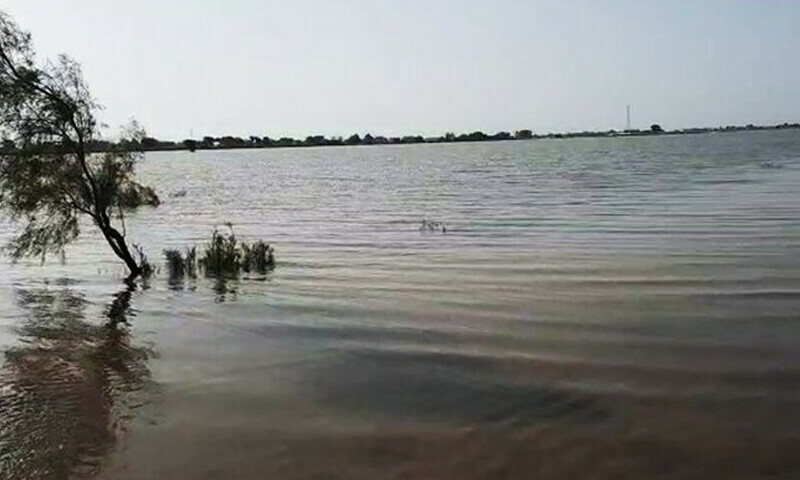Sehwan still trapped in the eye of Manchhar storm
The Express Tribune, September 06, 2022
SEHWAN: The historical town of Sehwan continued to face flood risk, as water level kept rising in Manchhar lake on Tuesday despite a number of controlled breaches in its embankments, while the flood torrents reached the main Indus Highway, which may sever Sehwan’s link to Dadu.
Irrigation authorities in Sindh cut open an embankment of Manchhar – the country’s largest freshwater lake – at Yousuf Bagh on Sunday to prevent an imminent flooding of Sehwan and Bhan Saeedabad after the lake water rose to dangerous level.
But when the single breach could not ease the pressure on the lake, which is spread over 200 square kilometres, two more breaches were made on Monday after the water level rose to 126 reduced levels (RL).
However, despite the breaches, the situation remained precarious, as the water level kept on rising in Manchhar. As a result, the threat of inundation of Sehwan and Bhan Saeedabad still remained.
A fourth breach in the lake’s embankment was made on Tuesday at Zero Point, which inundated dozens of villages in nearby area. Three people were swept away by the gushing waters after the breach was made but they were rescued by locals.
The residents started evacuating their homes and carried whatever they could to save their possessions from floodwaters. An official said that the gushing water from the latest breach might inundate many more areas, including Bhan Saeedabad.
“Till yesterday there was enormous pressure on the dikes around Johi and Mehar towns, but people are fighting it out by strengthening the dikes,” Murtaza Shah, a district administration official said, adding that 80% to 90% of townspeople had already fled.
Meanwhile, a slow-moving tsunami continued its journey towards the lower parts of the province, sweeping away towns, villages and other human settlements in its way. The floodwater reached the Indus Highway between Sehwan and Dadu.
According to locals and officials from the irrigation department, Dadu would soon be cut off from Sehwan as the water from Manchhar lake was expected to inundate the region. Several families were reportedly stranded by the floodwaters.
The rising waters also inundated the nearby Sehwan airport, civil aviation authorities said. The Indus Highway was already inundated near the flooded Khairpur Nathan Shah, making road travel to Larkana from Karachi, Hyderabad and Dadu near impossible.
According to the provincial government and the irrigation offices, the flood situation at Manchhar is expected to last at least eight to 10 days. The lake’s water would be released to the Indus River in a higher quantity only after reduction of the flood level in the river.
Sindh government spokesperson Murtaza Wahab said that the water in the Indus river was also increasing instead of decreasing. He added more cuts had been made in Manchhar banks to reduce the water pressure.
Worse yet to come
More than 33 million people have been affected by the flooding up and down the country, brought on by record monsoon rains amplified by climate change. The floods have caused at least 11,325 deaths and washed away homes, businesses, roads and bridges.
The United Nations warned that the humanitarian situation was expected to get worse. The UN’s World Health Organization said more than 1,460 health centres had been damaged, of which 432 were completely wrecked, the majority of them in Sindh.

Diseases, including acute watery diarrhoea, malaria, dengue, hepatitis and chikungunya were already circulating in #Pakistan, alongside Covid-19, HIV and polio, and “now all these are at risk of getting worse”, WHO spokesperson Tarik Jasarevic told reporters in Geneva.
“We have already received reports of increased number of cases of acute watery diarrhoea, typhoid, measles and malaria, especially in the worst-affected areas,” Jasarevic said. “The situation is expected to worsen,” Jasarevic warned.
Jasarevic said it was still difficult to get to areas hit hard by the floods.
He added that mortality among new-born babies and severe acute malnutrition were at risk of increasing due to disruption of services.
UNHCR, the UN refugee agency, has launched an air bridge to deliver aid from Dubai. The first four flights took off on Monday, said Indrika Ratwatte, UNHCR’s regional director for Asia and the Pacific.
Six other flights are planned, with mattresses, tarpaulins and cooking utensils on board. “The food insecurity is going to be huge because the crops are devastated, obviously, and the little they had in terms of livestock is also destroyed,” Ratwatte added.







